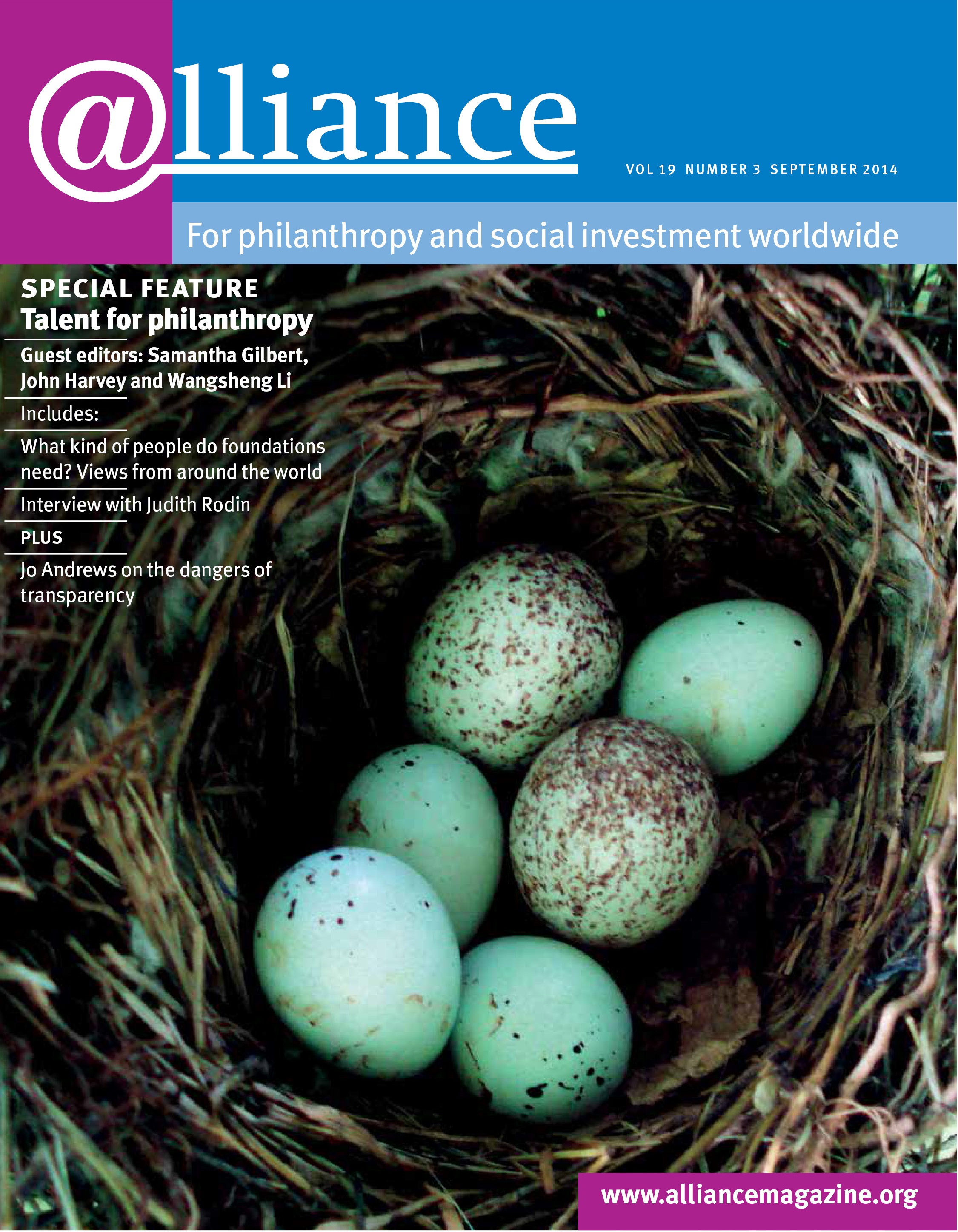Can the philanthropic sector learn from other areas, in particular the for-profit sector? Should talent management practice within philanthropy be exactly like it is in the business sector, or are we different enough to warrant a different set of practices? My answer is yes and no, meaning that learning from other sectors is possible on certain conditions. The opportunities to learn from other sectors are numerous, yet to learn how to best nurture talents and assimilate techniques to that end, you need to have a certain set of values and attitudes within your organization.
First, a cognitive and emotional make-up that allows you to learn. To be valuable, every learning experience needs to be shocking. You need to keep an open mind and be ready to be shocked, which also means being ready to relinquish power, open up new perspectives, give credit to new ideas and adopt a creative and experimental approach. You can’t do this if your organization is too hierarchical and rigid, if leaders are too detached from the reality of their world. At the same time, the shock needs to be contained within certain boundaries so that people can willingly and gradually adjust their mindset and behaviour.
Second, attitude. There won’t be any shocking revelations if we do not look around with curiosity, seeking excellence. No new learning is possible when you think you’re the best. So you need to encourage listening and thinking, while incessantly looking for alternatives and innovation.
Third, diversity. You learn a lot from those who are different from you, little from those who are similar to you. So you need to spend time with the non-mainstreamers, the eccentrics, the mavericks, the garage innovators.
The EFQM Excellence Model
Having said that, we can attempt to pinpoint some areas where the philanthropic sector can learn and benefit from well-established practices in the for-profit sector. First of all, at a general level, it can benefit from study of the quality management system, which is still the most advanced management system. Specifically, the management approach and model proposed by EFQM, the European Foundation for Quality Management (www.efqm.org), can be applied with considerable effectiveness in the philanthropic sector as well.
The EFQM Excellence Model is based on nine criteria. Five of these are ‘Enablers’ and four are ‘Results’. Leadership, people, policy and strategy, partnerships and resources, and processes are enablers. People satisfaction, grantee or project results, social impact and key performance are results. The EFQM model is used as a framework to drive strategy, identify priorities and measure the level of excellence attained or to be pursued. What the model does, in particular, is make the organizational approach and strategy explicit as well as promoting an organizational culture based on innovation and learning.
The process we at Fondazione Cariplo have gone through is based on this quality model. We have gone through repeated cycles of structured self-analysis that involved our entire organization. Everyone in the organization has contributed to the vision for improvement and to identifying four organizational strategies at the end of the journey:
- embedding a culture for improvement in the organization;
- measuring processes and performances;
- gaining an in-depth understanding of grantees and their needs by listening to them;
- benchmarking against global best practice.
Clearly, you do not need a model to embark on a journey to excellence, but having a model with a structured method compels top management to state openly and clearly what they intend to do and where they intend to take the organization. Additionally, having a model means there is no room for excuses and makes people share goals.
Tried-and-tested management techniques
Another area in which the philanthropic sector can learn from the for-profit sector has to do more with operational management than strategy. I’m referring to management techniques developed by different players in the for-profit sector that have been around for some decades. There is no need to reinvent the wheel. These include project management, cash flow management, time management, people satisfaction and team management.
In project management, for example, it may be very helpful to adopt proven, broadly used methods like those developed by the Project Management Institute (www.pmi.org). Foundations often prefer approaches that are original. They should consider adopting one of these methods, training their entire organization to use it consistently.
Another method that may prove useful is analysis of dynamic systems which allows one to identify the drivers of change in a system that is evolving. Foundations often deal with systems – cultural, societal, environmental – that undergo continuous change, and analysis of the dynamic system may help them design their projects by identifying what drives change. In particular, a general analysis of the dynamic system, a clear definition of goals in terms of change that is being pursued, and accurate planning should be the key elements of any project undertaken.
The importance of design and planning
It is odd that in recent years, while almost unanimously stressing output and impact measurement, the philanthropic sector has paid relatively little attention to design and planning. In my opinion, measurement is meaningless without proper design and thorough planning, so the first skills that need to be developed are design and planning skills.
Excellent design and planning also enables more effective measurement of progress made and change generated. Such a scientific approach is still rarely seen in the philanthropic sector. To have it, it takes, first and foremost, consistency and continuity.
Creating our own way of being excellent
True excellence, however, cannot be built just on techniques and approaches learned from others, albeit highly productive. We need to create our own way of being excellent. The for-profit sector can teach us much, but philanthropy has its own traits which distinguish it and make it a complex, separate sector. The for-profit sector tends to see people as mere economic resources or, worse, as commodities. As processes have become more abstract and fragmented, hence increasingly independent of the human element, people have become easily replaceable.
Ethically and historically questionable, even in the for-profit sector, this is something that is utterly unthinkable in the philanthropic sector. If, in the for-profit sector, an oppressive, abstract esprit de géométrie may prevail at times, in philanthropy the human element is a crucial inherent component, the benchmark against which success is measured. People are key elements both in philanthropic processes and in the success of philanthropic work. Philanthropic outcomes depend not only on the use of proper methods but also on the ‘human touch’, the sensitivity of people, their intuition, their creative stories, their esprit de finesse. More than in any other sector, in philanthropy the outcome depends on the quality of people. Are we doing all that we can within our foundations to build a social ecosystem (in terms of governance, delegation, reward, transparency, values, etc) that promotes free expression of ideas and criticism, creativity and happiness?
The philanthropic team is more a team of advisers than a team of executors. Managing philanthropic staff is not an easy task as it is not based on command and control but on harnessing people’s personal abilities and learning skills. Foundations cannot be good at what they do unless they become learning organizations.
Organizational excellence not for the faint of heart
Organizational excellence in our field cannot therefore be attained through mere imitation of techniques developed by others. Excellence is individual, historically limited, cut-to-measure, impossible to transfer or produce on an industrial scale; it is cusp-shaped. Excellence is highly unstable. It requires a number of good things – but one bad thing, and you miss it or lose it.
The energy and commitment needed for organizational excellence are so high that I recommend all foundation directors to embark on this journey only under special conditions. This is not a task for the faint of heart, those who are lazy, dull or lacking creativity; not for the pessimist, the rationalist, the bureaucrat, the envious, the cheapskate. This is a task that only those with a deep love for their organization and people can attempt, without expecting anything in return other than growth of the people they lead.
Pier Mario Vello was the secretary general of Fondazione Cariplo. He wrote this article shortly before his untimely passing away. This issue of Alliance is dedicated to him.







Comments (1)
"Are we doing all that we can within our foundations to build a social ecosystem...that promotes free expression of ideas and criticism, creativity and happiness?" "This is a task that only those with a deep love for their organization and people can attempt, without expecting anything in return other than growth of the people they lead." (Pier Mario Vello) Powerful statements from the the late Pier Mario Vello. Thank you for your inspiring contribution to European philanthropy.